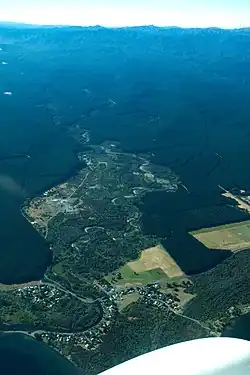Tauranga Taupō
Tauranga Taupō is a semi-rural area located at the mouth of Tauranga Taupō River, on the southern shores of Lake Taupō in New Zealand's North Island.
Tauranga Taupō | |
|---|---|
Rural settlement | |
 Tauranga Taupō River and settlement | |
| Coordinates: 38.910881°S 175.903644°E | |
| Country | New Zealand |
| Region | Waikato region |
| District | Taupō District |
| Ward | Turangi-Tongariro Ward |
| Community | Turangi-Tongariro Community |
| Electorates | |
| Government | |
| • Territorial Authority | Taupō District Council |
| • Regional council | Waikato Regional Council |
| Area | |
| • Total | 2.75 km2 (1.06 sq mi) |
| Population (June 2023)[2] | |
| • Total | 170 |
| • Density | 62/km2 (160/sq mi) |
Settlements
The area includes three contiguous settlements: Oruatua, near the mouth of the Tauranga Taupō River. [3] Te Rangiita or Rangiita,[4] and Waitetoko or Waitetoko Beach.[5] These settlements are located southwest to northeast on State Highway 1.[3][4][5]
The closest towns are Tūrangi which is 13km south of Te Rangiita and Taupō, which is 37km northwest .
History
The shores of Lake Taupō were first inhabited by Ngāti Hotu during the fourteenth century.[6] Māori legends speak about explorers Tia and Ngātoro-i-rangi, who competed to claim land along the shores of Lake Taupō[7] and passed through Tauranga Taupō. The children of Ngātoro-i-rangi's descendant Tūwharetoa[8] came to the Taupō District and created the iwi Ngāti Tūwharetoa. A descendant of Tūwharetoa named Te Rangi-ita and his son Tama-mutu became important figures in the iwi around the seventeenth century.[9] They were warrior chiefs who established territories in the Taupō District and established the Ngāti Te Rangi-ita hapū in the Tauranga Taupō area.[10]
Colonisation
Europeans began arriving to the Taupō area in the early nineteenth century.[11] The first road along the south eastern side of the lake was built in 1883. 1924 saw the construction of the Tauranga-Taupō bridge completing the road from Taupō to Tokaanu.[12] This would later become State Highway One.
Māori Sites
The local Waitetoko Marae is a marae for the local Ngāti Tūwharetoa hapū of Ngāti Te Rangiita.[13] It includes Te Kapua Whakapipi meeting house.[14]
Demographics
Statistics New Zealand describes Oruatua-Te Rangiita-Waitetoko as a rural settlement, which covers 2.75 km2 (1.06 sq mi)[1] and had an estimated population of 170 as of June 2023,[2] with a population density of 62 people per km2. The settlement is part of the larger Lake Taupo Bays statistical area.[15]
| Year | Pop. | ±% p.a. |
|---|---|---|
| 2006 | 147 | — |
| 2013 | 147 | +0.00% |
| 2018 | 162 | +1.96% |
| Source: [16] | ||
Oruatua-Te Rangiita-Waitetoko had a population of 162 at the 2018 New Zealand census, an increase of 15 people (10.2%) since the 2013 census, and an increase of 15 people (10.2%) since the 2006 census. There were 69 households, comprising 81 males and 81 females, giving a sex ratio of 1.0 males per female. The median age was 53.3 years (compared with 37.4 years nationally), with 24 people (14.8%) aged under 15 years, 24 (14.8%) aged 15 to 29, 75 (46.3%) aged 30 to 64, and 39 (24.1%) aged 65 or older.
Ethnicities were 75.9% European/Pākehā, 31.5% Māori, 3.7% Pacific peoples, 1.9% Asian, and 3.7% other ethnicities. People may identify with more than one ethnicity.
Although some people chose not to answer the census's question about religious affiliation, 53.7% had no religion, 35.2% were Christian, 1.9% had Māori religious beliefs and 1.9% had other religions.
Of those at least 15 years old, 15 (10.9%) people had a bachelor's or higher degree, and 24 (17.4%) people had no formal qualifications. The median income was $24,900, compared with $31,800 nationally. 15 people (10.9%) earned over $70,000 compared to 17.2% nationally. The employment status of those at least 15 was that 54 (39.1%) people were employed full-time, 24 (17.4%) were part-time, and 6 (4.3%) were unemployed.[16]
References
- "ArcGIS Web Application". statsnz.maps.arcgis.com. Retrieved 11 November 2022.
- "Subnational population estimates (RC, SA2), by age and sex, at 30 June 1996-2023 (2023 boundaries)". Statistics New Zealand. Retrieved 25 October 2023. (regional councils); "Subnational population estimates (TA, SA2), by age and sex, at 30 June 1996-2023 (2023 boundaries)". Statistics New Zealand. Retrieved 25 October 2023. (territorial authorities); "Subnational population estimates (urban rural), by age and sex, at 30 June 1996-2023 (2023 boundaries)". Statistics New Zealand. Retrieved 25 October 2023. (urban areas)
- Hariss, Gavin. "Oruatua, Waikato". topomap.co.nz. NZ Topo Map.
- Hariss, Gavin. "Te Rangiita, Waikato". topomap.co.nz. NZ Topo Map.
- Hariss, Gavin. "Waitetoko, Waikato". topomap.co.nz. NZ Topo Map.
- Bolton, Kerry R. (31 December 2010), "Enigma of the Ngati Hotu", Antrocom: Journal of Anthropology, Gorgias Press, pp. 123–126, doi:10.31826/9781463233983-017, ISBN 9781463233983, retrieved 11 January 2022
- Stokes, Evelyn (1999). "Tauponui a Tia: an interpretation of Maori landscape and land tenure". Asia Pacific Viewpoint. 40 (2): 137–158. doi:10.1111/1467-8373.00088. ISSN 1467-8373.
- Hata, Hoeta Te; Fletcher, H. J. (1916). "The Ngati-Tuharetoa Occupation of Taupo-Nui-A-Tia". The Journal of the Polynesian Society. 25 (3(99)): 104–116. ISSN 0032-4000. JSTOR 20701145.
- Hata, Hoeta Te; Fletcher, H. J. (1916). "The Ngati-Tuharetoa Occupation of Taupo-Nui-A-Tia". The Journal of the Polynesian Society. 25 (3(99)): 104–116. ISSN 0032-4000. JSTOR 20701145.
- Wikaira, Martin (8 February 2005). "Ngāti Tūwharetoa - Warfare". Te Ara - the Encyclopedia of New Zealand.
- WARD, R. GERARD (1956). "Maori Settlement in the Taupo Country, 1830-1880". The Journal of the Polynesian Society. 65 (1): 41–44. ISSN 0032-4000. JSTOR 20703532.
- Mathews & Mathews Architects Ltd (27 March, 2009). Central Taupo: Heritage Assessment (issue 5). Prepared for Taupo District Council. Retrieved from https://www.taupodc.govt.nz/repository/libraries/id:25026fn3317q9slqygym/hierarchy/our-council/policies-plans-and-bylaws/structure-plans/taupo-urban-commercial-and-industrial-structure-plan/documents/technical-background-reports/Heritage-Assessment.pdf
- "Māori Maps". maorimaps.com. Te Potiki National Trust.
- "Te Kāhui Māngai directory". tkm.govt.nz. Te Puni Kōkiri.
- 2018 Census place summary: Lake Taupo Bays
- "Statistical area 1 dataset for 2018 Census". Statistics New Zealand. March 2020. 7013301.